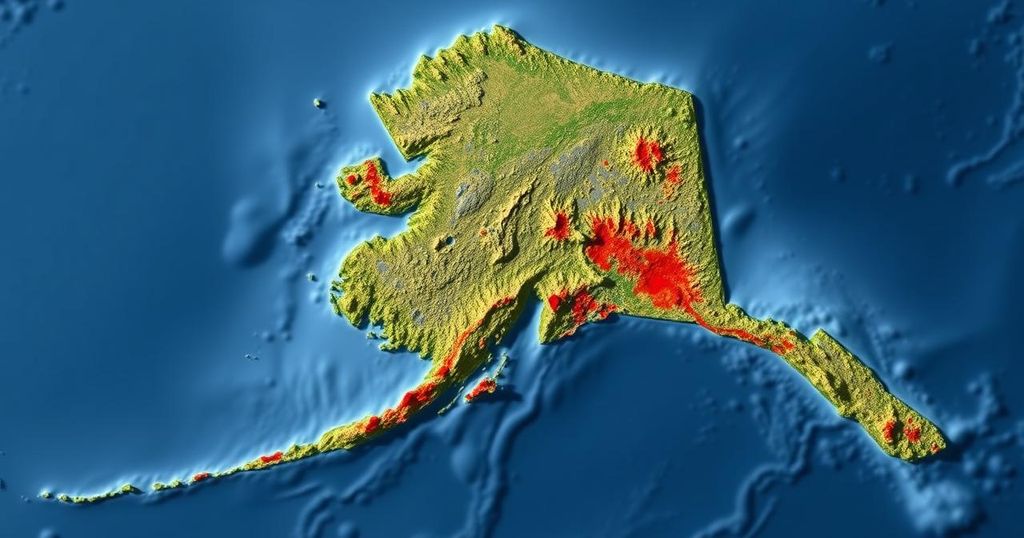Overview of the 2024 Tatitlek Earthquake and Tectonic Activity in Southern Alaska

An earthquake with a magnitude of 1.5 struck 45 miles northwest of Tatitlek, Alaska, on October 16, 2024. Not yet reviewed by a seismologist, this event exemplifies the underlying seismic activity stemming from complex tectonic interactions in Southern Alaska. The area is vulnerable to significant seismic events due to the ongoing subduction of the Pacific Plate underneath the North American Plate, alongside other local geological structures contributing to crustal seismicity.
On October 16, 2024, at 05:05:39 AKDT, a mild earthquake with a magnitude of 1.5 struck approximately 45 miles northwest of Tatitlek, Alaska. The seismic event registered no depth, indicating a close-to-surface occurrence. It was located at coordinates 61.3268°N and 147.6267°W. Despite being notable, this earthquake has not yet undergone review by a seismologist and its limited magnitude may have minimized any potential impact or recognition. Geographically, this earthquake is situated 45 miles west of Valdez, 49 miles southeast of Sutton, and similarly distanced from multiple notable locations, including Palmer, Whittier, and Girdwood. The event’s regional context is underscored by its proximity to larger metropolises such as Anchorage and Fairbanks, highlighting the seismic activity prevalent in Southern Alaska. The tectonic framework of Southern Alaska reveals a complex interplay of geological features responsible for seismic activities. The primary driver behind the most substantial earthquakes in this region is attributed to the megathrust fault delineating the interface between the Pacific and North American tectonic plates. Noteworthy historical earthquakes, such as the 1964 M9.2 Great Alaska Earthquake, exemplify the potential severity of seismic occurrences within this landscape. Intermediate-depth seismic events, specifically those at depths exceeding 20 miles, are characteristic of the Wadati-Benioff Zone, where the Pacific Plate converges with the North American Plate. Significant recent examples include the 2016 M7.1 Iniskin and the 2018 M7.1 Anchorage earthquakes, both of which underscored the capacity for substantial ground motion and ensuing infrastructure damage in the Southcentral region. Crustal seismicity within Southern Alaska can primarily be ascribed to notable faults and the geological structures present in the Cook Inlet basin. For instance, the Castle Mountain Fault near Anchorage evidences Holocene displacements and was known to generate the 1984 M5.6 Sutton Earthquake. Moreover, the diffuse seismicity extending from Cook Inlet to the Denali Fault reflects the region’s rich tectonic complexity, delineating a boundary of deformation between the Bering microplate and the Southern Alaska block. Historically, the 1943 M7.0 earthquake is presumed to have been triggered within this seismic band, further emphasizing the geological activity that permeates this region.
The seismic activity in Southcentral Alaska is influenced by multiple tectonic features that define the area’s geological landscape. The megathrust fault represents the primary mechanism through which substantial earthquakes occur when the Pacific Plate subducts beneath the North American Plate. This tectonic interaction not only results in catastrophic events such as the Great Alaska Earthquake of 1964 but also contributes to a more frequent incidence of intermediate-depth earthquakes associated with the Wadati-Benioff Zone. This zone features significant seismic events occurring at considerable depths due to the ongoing subduction of the Pacific Plate under the NA Plate. Furthermore, the crustal seismicity comprises a diverse array of geological structures capable of producing earthquakes, with historical events illustrating both the risks and the ongoing stability challenges within this geologically active area.
In summary, the recent earthquake near Tatitlek, Alaska, although minor, serves as a reminder of the persistent seismic activity in the region, influenced by the dynamics of the Pacific and North American tectonic plates. The historical context reveals that Southern Alaska is subject to a range of seismic phenomena, ranging from surface events to profound intermediate-depth shocks, driven by both megathrust mechanisms and local geological configurations. Understanding these dynamics is crucial for recognizing the associated risks and implementing adequate preparedness measures in this tectonically active environment.
Original Source: earthquake.alaska.edu







